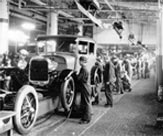Alan Mulally, President & CEO, talks about Ford's New Vision
Entry Level Wage Structure
Entry Level Wages
Much debate has taken place about entry level wages or a “two-tier wage structure” in the automotive industry lately. As part of our last national labor contract, the UAW and Ford reached an agreement on compensation and benefits for newly hired, entry level employees. This entry level wage structure enables Ford to blend our labor rate and make significant progress in closing our labor cost gap with that of transplants (non-U.S. automakers). The entry level wages negotiated initially represent an approximate 50 percent decrease compared to the wage level for existing employees. This gap narrows over time as a result of subsequent bi-annual guaranteed wage increases up to a “max rate”, as well as other pay escalators that are tied to overall economic indicators. This new wage structure allows Ford to meet our business needs while providing cost savings, and it enables us to remain competitive. As a result, we’re able to invest additional capital in U.S. plants and in-source some work currently being done by outside suppliers, including some from overseas.
Our UAW-Ford national agreement states that 20 percent of Ford’s workforce, at any one time, can be classified as entry level. In addition, two component plants, Ford’s Rawsonville Plant (Ypsilanti, Mich.) and our Sterling Plant (Sterling Heights, Mich.), have no cap and can be staffed 100 percent by entry level employees. Ford believes this structure is beneficial to the company and our employees for many reasons — including giving the high-seniority employees the ability to stay in the jobs they desire and protecting their wage rate, while blending our overall average labor costs to provide for our long-term competitiveness in the U.S. auto industry.
But something that hasn’t made its way into the discussion about the issue is that over time, Ford’s agreement with the UAW allows for entry level employees to move up into a pay structure that is the same as that of higher-seniority employees. In other words, entry level employees will not remain at an entry level throughout their careers with Ford. Once the 20 percent threshold has been reached and as higher-seniority employees retire or leave the company for other reasons, employees from the entry level will move into the higher-tier wage rate, making room for a new hire at the entry level. This provides opportunities for a career path and upward mobility among our workforce while allowing Ford to keep our overall labor costs at a more competitive level.
In 2009, GM and Chrysler reached contract modifications with the UAW, which allowed them to freeze the max grow-in rate at lower levels, as well as entirely eliminate the pay escalator for entry level employees. Ford sought the same modifications, but they were not agreed to by the UAW membership. As a result, we have hired relatively few employees at the full-time entry level. Later this year, when the UAW and Ford negotiate a new national contract, there is an opportunity for us to reach parity with our domestic competitors in our entry level agreements.
Highlights of 2007 Agreement
- New entry level wage classification started at $14.20 in 2007 and increased to $15.34 per hour over a two-year period (approximately 50 percent of higher seniority employee wages). Since 2007, there have been three contractual increases to entry level wage rates. They now start at $15.52 and increase to $17.28 per hour after two years. Beginning in the eighth month of employment, entry level employees receive health care coverage at a higher cost share percentage than higher-seniority employees.
- All new Ford production employees will be hired as entry level employees and can be assigned to any non-skilled job within the plant. The 20 percent cap can increase with additional in-sourced work, and two plants — Rawsonville and Sterling — can have 100 percent entry level employees, which is not counted toward the 20 percent production cap.
- Entry level employee benefits include: a cash-balance pension plan to which Ford will contribute 6.4 percent of employees’ wages; high health care cost sharing; and a defined contribution plan in which Ford will contribute to an employee 401(k) plan in the amount of one dollar for each compensated hour worked in lieu of post-retirement health care.







